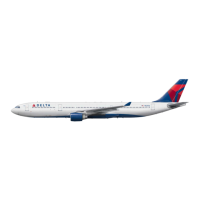FLIGHT CREW TRAINING MANUAL
ABNORMAL OPERATIONS
MISCELLANEOUS
03.090
JAN 09/07
EMERGENCY DESCENT
R MSN 0002-0860
R(1)
The emergency descent should only be initiated upon positive confirmation that
cabin altitude and rate of climb is excessive and uncontrollable. This procedure
should be carried out by the crew from memory. The use of AP and autothrust
is strongly recommended for an emergency descent. The FCU selections for an
emergency descent progress from right to left, i.e. ALT, HDG, SPD.
At high flight levels, the speed brake should be extended slowly while monitoring
VLS to avoid the activation of angle of attack protection. This would cause the
speedbrakes to retract and may also result in AP disconnection. If structural
damage is suspected, caution must be used when using speedbrakes to avoid
further airframe stress. When the aircraft is established in the descent, the PF
should request the ECAM actions if any or QRH.
The passenger oxygen MASK MAN ON pb should be pressed only when it is
clear that cabin altitude will exceed 14,000 ft.
When in idle thrust, high speed and speed brake extended, the rate of descent
is approximately 6000 ft/mn. To descend from FL410 to FL100, it takes
approximately 5 mn and 40 NM. The crew will be aware that MORA displayed on
ND is the highest MORA value within a circle of 40 NM radius around the aircraft.
EMERGENCY
DESCENT FLOW PATTERN
ENV A330/A340 FLEET FCTM Page 1 of 10

